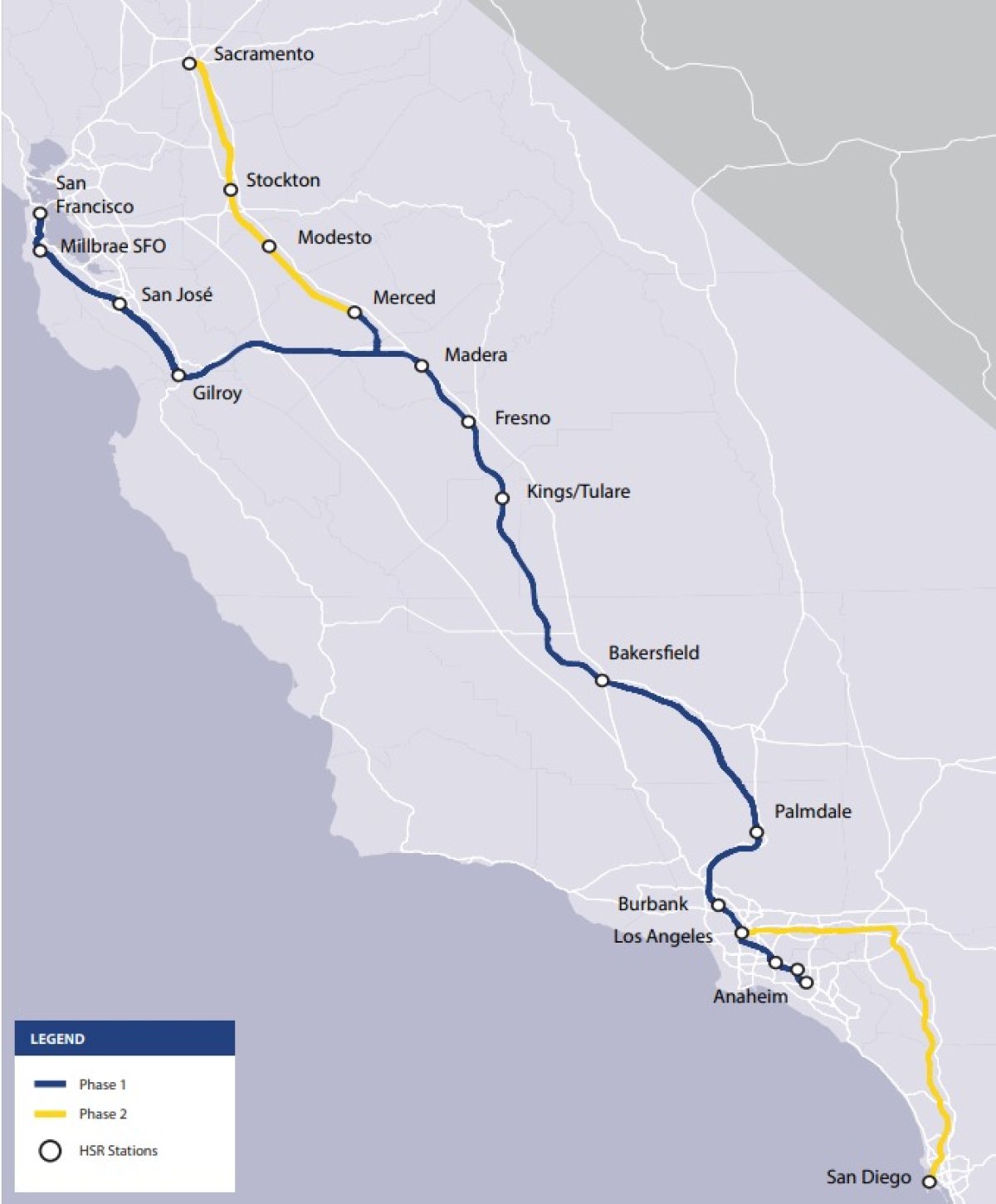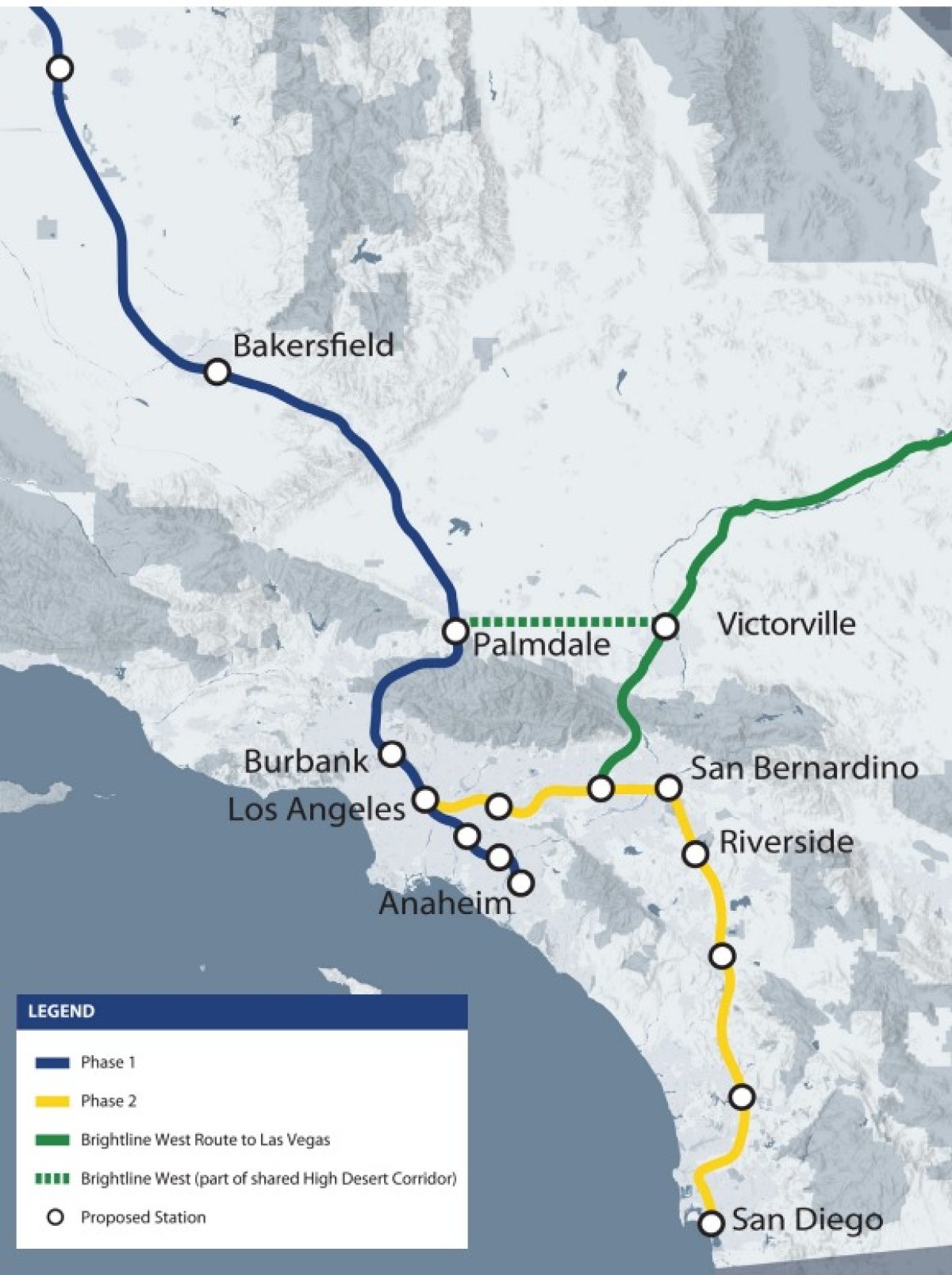Uncommon Knowledge
Newsweek is committed to challenging conventional wisdom and finding connections in the search for common ground.

A series of maps show the full extent of California’s proposed high-speed rail routes that would provide an efficient and quick way of travel between the state’s major cities.
Renewed interest has surfaced in high-speed rail travel after Brightline West, a new all-electric, 218-mile rail line bringing passengers from Las Vegas, Nevada, to Rancho Cucamonga, California, broke ground on Monday after construction was delayed for several years.
The project is expected to be completed before the 2028 Olympics in Los Angeles. The California High-Speed Rail Authority has another rail line planned that would provide a trip from San Francisco to Los Angeles in less than three hours, but progress has been slow.
Brightline West
According to maps on the Rail Authority’s website, the proposed high-speed rail line would traverse three regions—northern, central and southern California.
“The Phase 1 system will connect San Francisco to the Los Angeles basin via the Central Valley in under three hours on trains capable of exceeding 200 miles per hour,” the website said. “Phase 2 will extend to Sacramento and San Diego.”
A spokesperson for the Authority told Newsweek that the project is at an “exciting time.” There are 171 miles of rail line under construction, and there is environmental clearance for 422 miles.
“In the last year alone, the Authority has been awarded $3.3 billion in new federal funds to advance the work on the initial operating segment between Merced and Bakersfield, signifying a renewed federal partnership,” the statement said.

California High Speed Rail Authority
There are two legs to the northern California project. Phase 1 involves creating a high-speed rail line from San Francisco to Merced, with stops in between at Millbrae-SFO, San Jose and Gilroy. Phase 2 would bring travelers from Sacramento to Merced with stops at Stockton and Modesto.
For the San Francisco to San José leg of the journey, the Authority plans to introduce high-speed rail service to the Caltrain corridor. Environmental clearance was completed in 2022, and construction of the Caltrain electrification is under way.
Environmental clearance also was completed for the San José to Merced leg.
“Electrifying the existing rail corridor from San José to Gilroy will modernize the rail corridor for electrified high-speed rail service and allow Caltrain to extend electrified service to southern Santa Clara County,” the website said.

California High Speed Rail Authority
The middle stint of the statewide project travels from Merced to Bakersfield with rail stations at Fresno and Kings/Tulare. Construction is most promising in this segment.
“The electrified high-speed rail line between Merced and Bakersfield is the first building block of the statewide system. This 171-mile line will offer the nation’s first true electrified high-speed rail service,” the Authority said on its website.
The spokesperson told Newsweek that this leg of the project is expected to be completed by 2030 to 2033.

California High Speed Rail Authority
The southern California stint also involves two phases. Phase 1 would bring travelers from Bakersfield to Anaheim with stops in Palmdale, Burbank and Los Angeles. Phase 2 would travel from Los Angeles to San Diego with stops at San Bernardino and Riverside. The southern California map also shows the Brightline West route.

California High Speed Rail Authority
The statewide project has been plagued with delays and price jumps. Voters approved the project in 2008, KTLA reported, with Phase 1 taking travelers from San Francisco to Los Angeles. At the time, the project was anticipated to be operational by 2020 and cost $33 billion.
Four years past the deadline, the project is still far from being completed and the price has jumped to $128 billion.
“The full Los Angeles to San Francisco line completion date is contingent on federal funding,” the spokesperson told Newsweek.
According to a U.S. House testimony by Lee Ohanian, a UCLA professor and Stanford University fellow, California began its journey to high-speed rail in 1993 by creating the California Intercity High-Speed Rail Commission. Three years later, the commission was replaced by the California High-Speed Rail Authority.
“California’s HSR project has little to show over this 30-year period. The project is significantly delayed, and its budget has increased to about four times its initial cost. Some of this is due to mistakes in planning, management, oversight, and accountability,” Ohanian testified.
“But other factors reflect more endemic challenges in building HSR, including limitations in understanding the scope and size of the problems and risks that can arise in such a major infrastructure project.”
Newsweek is committed to challenging conventional wisdom and finding connections in the search for common ground.
Newsweek is committed to challenging conventional wisdom and finding connections in the search for common ground.


Hub International Ltd. acquired Merriwether & Williams Insurance Services Inc.
Merriwether & Williams has locations in San Francisco and Los Angeles, California, The firm provides contractor development abd bonding programs, aligned risk management and special project consulting, and insurance brokerage services.
President & CEO Ingrid Merriwether and the Merriwether & Williams team will join Hub Central & Northern California. Merriwether will become president of Hub Aligned Risk Management Services. Merriwether & Williams will be referred to as Merriwether & Williams Insurance Services Inc., a Hub International company.
Chicago, Illinois-based Hub is an insurance broker and financial services firm providing risk management, insurance, employee benefits, retirement and wealth management products and services.
Topics
California
Mergers & Acquisitions
Was this article valuable?
Here are more articles you may enjoy.
Get automatic alerts for this topic.

California is facing a multibillion-dollar budget deficit that will require lawmakers and the governor to make painful decisions. Nobody wants less funding for their child’s school, road maintenance, environmental progress or other essential services.
There is one area, however, where spending can and should be cut: prisons. Thousands of California prison beds are not in use. Simply consolidating and closing some facilities could ultimately save the state hundreds of millions of dollars.
This can be accomplished safely thanks to important reforms that have confronted our state’s incarceration crisis and reduced its prison population. According to the California Department of Corrections and Rehabilitation, nearly 130,000 people were in state custody in 2019; by the end of last year, that number had dropped to 96,000, a decrease of about 25%.
Today the state’s prison population is down to roughly 93,000. That leaves a surplus of about 15,000 prison beds, a number that is expected to grow to 19,000 in four years as the population continues to decline. It’s fiscally irresponsible to maintain those beds while social safety net programs are on the chopping block.
The empty beds mean that beyond the excess prisons, we’re continuing to incur unnecessary billions in staff, operations and maintenance costs. Consolidating and deactivating prisons provides a straightforward way to address the state’s budget deficit over the long term.
Gov. Gavin Newsom has closed two prisons and eight yards — each state prison typically comprises several yards — and discontinued one private prison contract, with another prison closure slated for next year. Even with these reductions, however, the vacancies are equivalent to four or five more empty prisons.
New York offers an example of what’s possible. With a prison population that has halved since 1999, the state has closed dozens of facilities in recent years. Gov. Kathy Hochul has proposed closing five more in the coming fiscal year.
California should follow suit. The state’s nonpartisan Legislative Analyst’s Office recently estimated that the state could save $1 billion in operating expenses annually and up to an additional $2 billion in capital expenses by closing five prisons. Otherwise, the office expects one-fifth of the state’s prison capacity to go unused.
A billion dollars a year could not only help close this and future deficits but also support real public safety measures: safety-net programs, education, housing and workforce development. The state’s current corrections budget is nearly $15 billion. The state’s general fund budget for the University of California? Under $5 billion.
Do we want updated school textbooks or surplus prison beds? Desperately needed affordable housing or unneeded prison yards? Should we pay people to watch an empty cell or build transportation infrastructure?
The Legislature should consider requiring corrections officials to rein in our sprawling prison system. Fortunately, an Assembly committee last month passed legislation that provides a road map for corrections officials to gradually and practically reduce excess capacity to 2,500, the number they have said they need to maintain operational flexibility. The bill also allows for situations in which the corrections department can make the case that an increase in beds is justified.
We understand that the administration is grappling with a need to invest more in rehabilitation as well as court mandates on prison capacity. The corrections department has struggled for many years to maximize rehabilitation and reduce recidivism. We believe making smart reductions to prison spending will free up more funding for community investment and rehabilitation, making Californians safer.
Assembly Bill 2178 answers the governor’s call for prison capacity reductions driven by data and need. It provides a pragmatic and flexible framework for such decisions. It also aligns with Newsom’s vision of a fiscally prudent, forward-thinking California.
Every dollar we spend on incarceration is one we don’t spend on building homes, supporting students and fighting climate change. With so many vital programs in jeopardy, we have a moral imperative to put the broader needs of Californians ahead of empty prisons.
Phil Ting is a Democratic Assembly member from San Francisco and the author of AB 2178. Amber-Rose Howard is the executive director of Californians United for a Responsible Budget. ©2024 Los Angeles Times. Distributed by Tribune Content Agency, LL

Three bodies were found Friday during an ongoing search for a group of surfers who went missing in Baja California, officials said.
Mexican authorities have yet to confirm if the bodies are those of San Diego resident Jack Carter and his companions from Australia, Callum and Jake Robinson.
State Attorney General Maria Elena Andrade said forensic exams were ordered to identify the bodies.
“We are in contact with the family of the U.S. Citizen, and we are steadfast with our international law enforcement partners in finding answers,” FBI officials said in a statement on Friday.
The search for the men began at the end of April when family and friends reported losing contact with them.
Callum and Jake Robinson are from Australia. Friends say Callum lived in Ocean Beach, and his brother was visiting. They say the brothers’ friend, Carter, is also from the San Diego area.
Friends and family said the group was on a surfing trip to celebrate a birthday. They said they last heard from the group on April 27 and grew worried when they didn’t check into their Airbnb in Rosarito as planned and when Callum did not return to work in San Diego.
According to the Baja California state attorney general, three people are under investigation, and arrest warrants were secured for the charge of forcible disappearance of people.
The FBI said it is working with Mexican authorities on the investigation.
This article was originally published by Athena Jreij and Laura Acevedo for Scripps News San Diego.


Columbia University’s policy-making senate votes for resolution calling to investigate school’s leadership


Both sides prepare as Florida's six-week abortion ban is set to take effect Wednesday


Brussels, my love? MEPs check out of Strasbourg after 5 eventful years


House Republicans brace for spring legislative sprint with one less GOP vote


At least four dead in US after dozens of tornadoes rip through Oklahoma


Pro-Palestinian campus protesters face looming deadlines and risk of arrest


GOP Rep. Bill Posey won't seek re-election, endorses former Florida Senate President as replacement


Republican makes major announcement in push to grow GOP support from once-solid Dem voting bloc